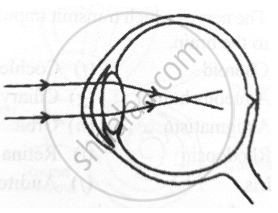Advertisements
Advertisements
Question
Which. of the following has normal vision?
(a) Xc Xc
(b) Xc Y
(c) XC Xc
(d) Xc Yc
Solution
(C) XC Xc
APPEARS IN
RELATED QUESTIONS
What is the function of the lens in the human eye?
Fill in the following blank with suitable word:
To bring light from a near object to a focus on the retina of the eye, the convex eye-lens need to be made....................
State the function of each of the following parts of the human eye:
(i) Cornea
(ii) Iris
(iii) Pupil
(iv) Retina
Millions of people of the developing countries are suffering from corneal blindness. This disease can be cured by replacing the defective cornea with the cornea of a donated eye. Your school has organised a campaign in the school and its neighbourhood in order to create awareness about this fact and motivate people to donate their eyes after death. How can you along with your classmates contribute in this noble cause? State the objectives of organising such campaigns in schools.
State the Function:
Iris
Write the name.
The part of human eye that transmits electrical signals to the brain.
The larynx has fold of tissue which vibrate with the passage of air to produce sound.
Given below is a diagram depicting a defect of the human eye. Answer the questions that follow:

- Give the scientific term for the defect.
- Mention one possible reason for the defect.
- What type of lens can be used to correct the defect?
| Column I | Column II | ||
| 1 | Retina | a | Path way of light |
| 2 | Pupil | b | Far point comes closer |
| 3 | Ciliary muscles | c | near point moves away |
| 4 | Myopia | d | Screen of the eye |
| 5 | Hypermetropia | e | Power of accomodation |
Match the following:
| Column - I | Column - II |
| 1. Retina | a. Path way of light |
| 2. Pupil | b. Far point comes closer |
| 3. Ciliary muscles | c. near point moves away |
| 4. Myopia | d. Screen of the eye |
| 5. Hypermetropia | e. Power of accommodation |
Match the following:
| Column - I | Column - II | ||
| 1 | Retina | a | Path way of light |
| 2 | Pupil | b | Far point comes closer |
| 3 | Ciliary muscles | c | near point moves away |
| 4 | Myopia | d | Screen of the eye |
| 5 | Hypermetropoia | e | Power of accomodation |
